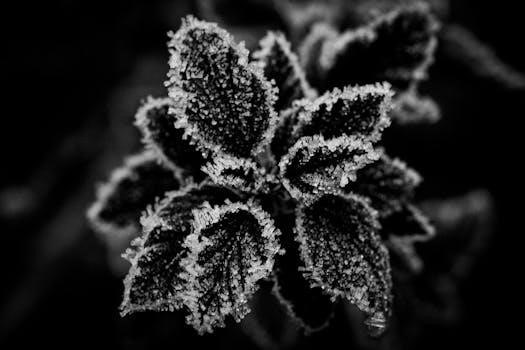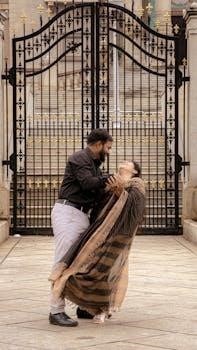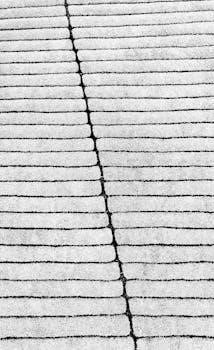Chrismons, a blend of “Christ” and “monogram”, are Christian symbols used as Christmas ornaments. These unique ornaments often depict aspects of Jesus’ life and ministry. Many patterns are available for crafting these meaningful decorations, often found in PDF format online. These patterns help create beautiful white and gold ornaments.
What are Chrismons?
Chrismons are distinctive Christmas ornaments that utilize Christian symbols to represent various aspects of Jesus Christ’s life, ministry, and teachings. They are not merely decorative items, but rather, they serve as a visual testament to the Christian faith and the true meaning of Christmas. Traditionally, these ornaments are crafted in white, symbolizing purity and perfection, and gold, representing His majesty and glory, however, they can also be created in other colors. Chrismons often feature well-known Christian symbols such as the cross, the dove, the anchor, and the Alpha and Omega, each holding a significant theological meaning. These ornaments are typically displayed on special Christmas trees, known as Chrismon trees, making them a unique and meaningful tradition during the holiday season. The patterns for creating these symbolic ornaments can be found in various sources, often in PDF format.

The Significance of Chrismons
Chrismons hold deep significance, representing core Christian beliefs through visual symbols. They serve as reminders of Jesus’ life and teachings. These ornaments enhance the spiritual meaning of the Christmas season. Chrismons are more than decorations.
Symbolism in Chrismon Ornaments
Chrismon ornaments are rich with symbolism, each design carrying a specific meaning related to Christian faith. The Alpha and Omega represent Jesus as the beginning and the end, reflecting his eternal nature. An anchor signifies hope and steadfastness in Christ. A cross, the most recognizable symbol, recalls Jesus’ sacrifice. Many ornaments feature monograms, such as IHS or Chi Rho, which are early Christian abbreviations of Jesus’ name. Stars often symbolize the Star of Bethlehem, guiding the Wise Men. Other common symbols include the dove, representing the Holy Spirit, and the fish, an early Christian symbol. The use of these symbols on Christmas trees transforms them into visual representations of faith, fostering deeper spiritual reflection during the holiday season. Each ornament acts as a teaching tool, reminding observers of the core tenants of Christianity and the significance of Jesus’s life. These symbols connect believers to the ancient heritage of their faith, enhancing the Christmas celebration.
Traditional Chrismon Colors
The traditional colors for Chrismon ornaments are primarily white and gold, each holding significant meaning within the Christian tradition. White, the liturgical color for Christmas, symbolizes purity, perfection, and the sinless nature of Jesus Christ. It represents the immaculate conception and the holy essence of God incarnate. Gold, on the other hand, represents majesty, glory, and the kingship of Christ. It embodies the richness of God’s blessings and the heavenly nature of the divine. Often, white forms the base color of the ornament with gold accents used for trim, beads, and sequins, enhancing the visual appeal and symbolic depth. Occasionally, the colors may be inverted, with gold as the primary color and white as the accent, but the overall theme of purity and glory remains central. The consistent use of these colors ensures that Chrismons, when displayed on a Christmas tree or elsewhere, are immediately recognizable and reflective of their spiritual purpose.

Materials for Chrismon Creation
Chrismons can be crafted from various materials, including paper, felt, and foam sheets. Common additions include gold trim, glitter, beads, and sequins to enhance their appearance and reflect their spiritual significance.
Common Materials Used
When creating Chrismons, a variety of materials can be employed, each offering unique textures and visual effects. Felt is a popular choice due to its ease of use and availability in various colors, although white is the most traditional for Chrismons. Cardboard or cardstock provides a sturdy base for intricate designs, especially when layering is needed. Foam sheets, particularly fun foam, are also widely used, as they are easy to cut and decorate. For adding embellishments, gold paint, glitter glue, and sharpie markers are frequently used. These materials can be used to create highlights, add a touch of sparkle, and draw attention to key elements of the Chrismon. Additionally, embroidery floss and needlepoint canvas are common for creating more detailed and textured Chrismons. Beads, sequins, and other small decorative items can also be used to further enhance the overall look of the finished ornament. These combined materials help in creating beautiful and meaningful symbols of faith.
Alternative Materials
While traditional materials like felt and foam are common, several alternative materials can be used to create unique Chrismons. Paper, especially card stock, offers a versatile base for intricate cut-out designs, which can then be enhanced with gold accents. Plastic canvas is another option, particularly for those who enjoy needlepoint or cross-stitch techniques. Fabric scraps, particularly those with a shimmer or shine, can add a touch of elegance when used with an embroidery hoop. Additionally, natural materials such as thin pieces of wood or bark can be incorporated for a rustic look. For a more modern approach, consider using clear acrylic or plastic, which can be embellished with vinyl decals or paint. Consider using recycled materials like old greeting cards or even aluminum cans for an eco-friendly approach. The key is to explore creativity and find materials that suit your style and the desired effect for your Chrismon ornaments. Using different materials can make each ornament a unique expression of faith.

Finding Chrismon Patterns
Numerous sources offer Chrismon patterns, often in PDF format. These patterns are frequently available for free online. Websites, blogs, and church resources provide a variety of designs for crafting these special ornaments.
Sources for Free PDF Patterns
Finding free PDF patterns for Chrismons is quite achievable with a bit of online searching. Many websites dedicated to crafting, particularly those focused on Christian themes, offer a variety of downloadable patterns. These sites often provide patterns for different skill levels, from simple designs for beginners to more intricate ones for experienced crafters. Church websites and blogs are also excellent resources, frequently providing patterns as a way to encourage meaningful Christmas traditions. Some sites even offer patterns as part of Advent booklets, enhancing the spiritual aspect of the crafting process. Additionally, online craft communities and forums can be a valuable source, with members sharing their own designs and links to free resources. When exploring these options, look for the PDF format, which is commonly used for printable patterns. This format ensures that the patterns are easy to download and print, allowing you to begin your Chrismon crafting journey with convenience and ease. Be sure to check for permission of use, as some patterns may be for personal use only.
Downloading and Printing Patterns
Once you’ve located free Chrismon patterns in PDF format, the next step is downloading and printing them. Downloading is typically straightforward; most sites will have a clear download link or button. Be sure to save the PDF file to a designated folder on your computer for easy access later. When printing, it’s important to ensure that the pattern prints at the correct size. Look for any instructions provided on the pattern itself or on the website. Sometimes, patterns will include a test square or measurement to verify the print size. Adjust your printer settings, if necessary, to avoid scaling the image. Use standard printer paper for initial prints, but consider using cardstock for durability when creating the actual ornaments. If the pattern includes multiple pages, assemble them according to the instructions. With the pattern now in hand, you are well prepared to start the process of bringing your Chrismon designs to life. Enjoy this creative endeavor.

Crafting Techniques for Chrismons
Creating Chrismons involves various techniques, from basic cutting and gluing to more intricate embroidery and needlepoint. Common methods include using felt, foam, or paper, with gold accents added for visual appeal.
Basic Construction Methods
The foundation of crafting Chrismons often begins with simple construction techniques suitable for all skill levels. Many Chrismon patterns, especially those in PDF format, are designed with ease of assembly in mind. Typically, you’ll start by printing the desired pattern and transferring it onto your chosen material, be it felt, foam, cardstock or even paper. Cutting out the pattern accurately is a crucial first step, ensuring the final ornament matches the design. Once cut, the pieces are often assembled by gluing them together. For paper or cardstock Chrismons, this may involve simple folds and tabs, while felt and foam may require fabric glue or hot glue. Adding gold accents is a common practice, which can be achieved with markers, glitter glue, or even gold paint. These basic methods allow for the creation of beautiful and meaningful Chrismons that can be used to decorate trees or other surfaces.
Embroidery and Needlepoint
For those with a passion for needlecrafts, embroidery and needlepoint offer a beautiful avenue for crafting Chrismons. Many PDF patterns are available that are specifically designed for these techniques. These patterns often feature grid-based designs, making it easier to transfer the symbol onto fabric or canvas. Embroidery can be used to create intricate details on fabric using various stitches and threads, while needlepoint can utilize canvas and yarn to form the Chrismon. White fabric or canvas with gold thread is a common choice, staying true to the traditional Chrismon color scheme. The process may involve tracing the pattern onto the fabric, then carefully stitching over the lines. These methods allow for a more tactile and detailed approach to Chrismon making, which can result in beautiful and long-lasting ornaments. Some patterns even include instructions for specific embroidery stitches or needlepoint techniques, helping beginners learn as they create.
Using Chrismons
Chrismons are primarily used as decorations on Christmas trees, their white and gold colors symbolizing purity and majesty. They are also used in other decorative ways in churches and homes, and serve as a visual reminder of faith.
Chrismons on Christmas Trees
Chrismons find their most prominent display on Christmas trees, transforming them into powerful symbols of faith. Unlike traditional ornaments, Chrismons are not merely decorative; they serve as visual representations of Christian beliefs and the life of Jesus Christ. The white color, often used, symbolizes purity and perfection, while gold accents represent His majesty and glory. These ornaments, carefully crafted from patterns often found in PDF format, create a meaningful and spiritually rich Christmas tree. Each symbol, from the Alpha and Omega to the anchor, tells a story and invites reflection on the core tenets of Christianity. The use of Chrismons elevates the Christmas tree from a festive decoration to a powerful symbol of faith. The symbols are usually carefully selected to represent various aspects of Christ’s life, teachings, and the Christian faith itself. They provide an educational opportunity to learn more about Christian symbolism. The Chrismon tree is a visual reminder of the reason for the season and enhances the spiritual significance of Christmas.
Other Applications of Chrismons
Beyond adorning Christmas trees, Chrismons find diverse applications in various settings, extending their spiritual significance beyond the holiday season. These handcrafted symbols, often created using patterns found in PDF format, can be incorporated into church worship designs, enriching the atmosphere and reinforcing faith-based messages. Chrismons can be used to decorate church banners, wall hangings, and even educational materials, serving as constant reminders of Christian principles. Their symbolic nature makes them ideal for use in needlepoint and embroidery projects, creating beautiful and meaningful art pieces. Furthermore, Chrismons can be incorporated into personal art projects, fostering creativity and spiritual expression. The versatility of Chrismons allows them to be used in diverse ways to enhance spiritual practices and promote faith-based values in many different contexts. They are also used in advent booklets to teach the meaning of each symbol. The use of Chrismons extends to personal devotion.
